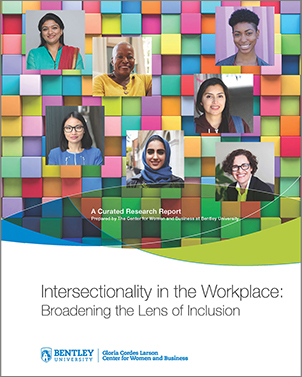Intersectionality Research Report Request
 Thank you for your interest in the Gloria Cordes Larson Center for Women and Business (CWB) curated research report Intersectionality in the Workplace: Broadening the Lens of Inclusion. Download the full report.
Thank you for your interest in the Gloria Cordes Larson Center for Women and Business (CWB) curated research report Intersectionality in the Workplace: Broadening the Lens of Inclusion. Download the full report.
Executive Summary
Intersectionality describes the unique ways race, gender, class, ethnicity, sexual orientation, age, ability, status, and other social and demographic identities come together to inform peoples’ lived experiences. Often, the resulting impact is discrimination, disadvantage, or oppression.
In this report, we explore intersectionality in the workplace. The topic, sometimes referenced in business settings as multi-dimensionality, is becoming increasingly important in corporate diversity and inclusion (D&I) efforts, as D&I practitioners and business leaders recognize that the key to creating an inclusive workplace is recognizing and valuing the multitude of employees’ unique identities.
Before diving in, it is critical for readers to note that intersectionality has its roots in social power, oppression, and marginalized individuals, and that a Black female activist, attorney, and academic, Kimberlé Crenshaw, coined the term. We discuss its origins in greater length in the report.
On the following pages, we focus primarily on the intersection of gender and the following markers: racial and ethnic identity; sexual orientation; ability/disability; age; religion; veteran status; class status; and cognitive diversity. Because race and gender are so often the focus of intersectionality, much of the report is devoted to this topic.
- We set the stage by providing historical perspectives, then explore the impact of intersecting identities on employees.
- Micro-inequities — subtle and often unintentional manifestations of unconscious bias — are discussed.
- We devote separate sections to the impact of being a minority of one — The Only — and the role of corporate leaders.
- Throughout the report, you will find Inclusive Actions, where we spotlight real-life impacts or actions to mitigate inequities.
- At the end of the report, readers will find two helpful sections:
- A checklist of action items to address the negative impacts of intersectionality.
- A glossary of terms related to intersectionality, diversity, and inclusion.
To provide greater context to the rather limited research and media coverage on intersectionality and the workplace, we conducted focus groups with individuals whose lived experiences exemplify intersectionality. Throughout the report, you will find relevant excerpts and references to those discussions.

